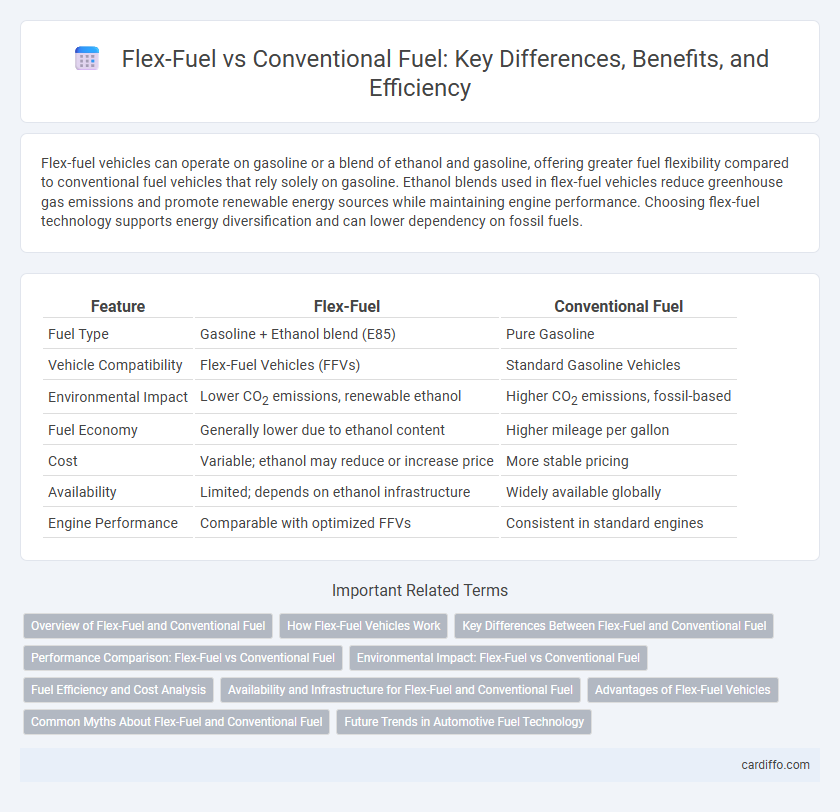Flex-fuel vehicles can operate on gasoline or a blend of ethanol and gasoline, offering greater fuel flexibility compared to conventional fuel vehicles that rely solely on gasoline. Ethanol blends used in flex-fuel vehicles reduce greenhouse gas emissions and promote renewable energy sources while maintaining engine performance. Choosing flex-fuel technology supports energy diversification and can lower dependency on fossil fuels.
Table of Comparison
| Feature | Flex-Fuel | Conventional Fuel |
|---|---|---|
| Fuel Type | Gasoline + Ethanol blend (E85) | Pure Gasoline |
| Vehicle Compatibility | Flex-Fuel Vehicles (FFVs) | Standard Gasoline Vehicles |
| Environmental Impact | Lower CO2 emissions, renewable ethanol | Higher CO2 emissions, fossil-based |
| Fuel Economy | Generally lower due to ethanol content | Higher mileage per gallon |
| Cost | Variable; ethanol may reduce or increase price | More stable pricing |
| Availability | Limited; depends on ethanol infrastructure | Widely available globally |
| Engine Performance | Comparable with optimized FFVs | Consistent in standard engines |
Overview of Flex-Fuel and Conventional Fuel
Flex-fuel vehicles are designed to operate on gasoline or a blend of up to 85% ethanol, offering greater fuel versatility and reduced greenhouse gas emissions compared to conventional fuels. Conventional fuel relies solely on fossil-based gasoline, which provides consistent energy density but contributes to higher carbon emissions. The growing adoption of flex-fuel technology supports renewable energy use and helps decrease dependence on petroleum-based fuels.
How Flex-Fuel Vehicles Work
Flex-fuel vehicles (FFVs) operate using a blend of gasoline and ethanol, typically E85, which contains up to 85% ethanol and 15% gasoline. Advanced sensors and engine control units automatically adjust fuel injection timing and air-fuel ratios to optimize combustion based on the ethanol-gasoline mix. This flexibility enables FFVs to run efficiently on varying ethanol blends, reducing greenhouse gas emissions and reliance on fossil fuels compared to conventional gasoline vehicles.
Key Differences Between Flex-Fuel and Conventional Fuel
Flex-fuel vehicles can operate on gasoline or a blend containing up to 85% ethanol (E85), while conventional fuel vehicles run exclusively on gasoline. Flex-fuel systems include sensors and engine calibrations that adjust to varying ethanol concentrations, optimizing performance and emissions. Conventional fuel engines lack these adaptations, resulting in less flexibility and typically higher emissions compared to flex-fuel counterparts.
Performance Comparison: Flex-Fuel vs Conventional Fuel
Flex-fuel vehicles (FFVs) demonstrate comparable performance to conventional fuel vehicles, with ethanol-blended fuels offering higher octane ratings that can enhance engine power and efficiency. While conventional gasoline provides consistent energy density, ethanol's cleaner combustion reduces engine knock and emissions, supporting optimized combustion cycles. However, the lower energy content of ethanol may result in slightly reduced fuel economy compared to traditional gasoline, affecting overall mileage.
Environmental Impact: Flex-Fuel vs Conventional Fuel
Flex-fuel vehicles utilize ethanol-blended fuels, reducing greenhouse gas emissions by up to 30% compared to conventional gasoline engines. Ethanol production from renewable sources like corn or sugarcane contributes to lower carbon footprints and decreased reliance on fossil fuels. However, land use changes and agricultural inputs for ethanol cultivation can offset some environmental benefits relative to traditional petroleum-based fuels.
Fuel Efficiency and Cost Analysis
Flex-fuel vehicles operate efficiently on ethanol blends like E85, offering up to 20% lower fuel economy compared to conventional gasoline due to ethanol's lower energy content. Despite reduced miles per gallon, ethanol fuels often cost less per gallon, potentially offsetting efficiency losses in overall fuel expenses. Conventional gasoline provides higher energy density, resulting in better fuel efficiency, but usually at a higher price point per gallon compared to flex-fuel options.
Availability and Infrastructure for Flex-Fuel and Conventional Fuel
Flex-fuel availability is expanding through dedicated pumps in Brazil, Sweden, and the United States, supported by government incentives and growing consumer demand. Conventional fuel infrastructure remains widespread globally, with millions of gas stations providing consistent access and established distribution networks. Emerging flex-fuel stations face challenges such as initial investment costs and slower market penetration compared to the mature conventional fuel system.
Advantages of Flex-Fuel Vehicles
Flex-fuel vehicles offer significant advantages by enabling the use of ethanol-blended fuels, which reduce greenhouse gas emissions and reliance on fossil fuels. These vehicles provide greater fuel flexibility and can operate on gasoline, ethanol, or any combination, promoting energy security and cost savings. Flex-fuel technology supports sustainable transportation and lowers overall carbon footprints compared to conventional fuel vehicles.
Common Myths About Flex-Fuel and Conventional Fuel
Flex-fuel vehicles can run on a blend of ethanol and gasoline, but a common myth suggests they always deliver lower fuel efficiency compared to conventional fuel vehicles; however, advances in engine technology have minimized this difference. Another misconception is that flex-fuel damages engines or voids warranties, when in fact automakers design these vehicles specifically to handle variable ethanol blends safely. Many assume ethanol blends cause higher emissions, yet studies show that ethanol can reduce certain tailpipe pollutants compared to pure gasoline.
Future Trends in Automotive Fuel Technology
Flex-fuel vehicles capable of running on ethanol blends are gaining traction due to increasing environmental regulations and carbon emissions targets worldwide. Advances in biofuel production and compatibility with existing engine technologies position flex-fuel systems as a key component of sustainable transportation. Conventional fuels, while still dominant, face declining demand as electric and alternative fuel innovations accelerate the shift toward greener automotive solutions.
Flex-Fuel vs Conventional Fuel Infographic

 cardiffo.com
cardiffo.com